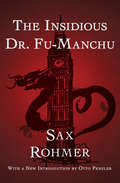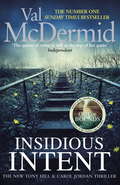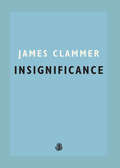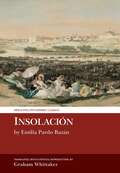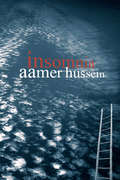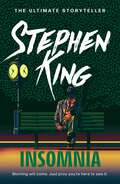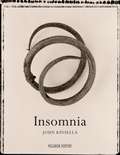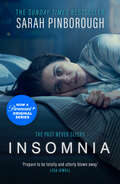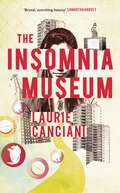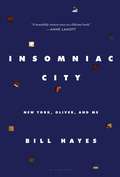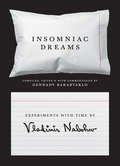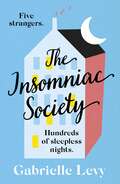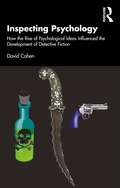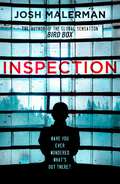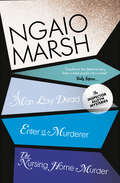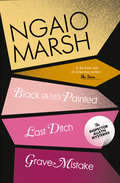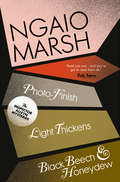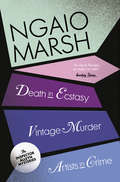- Table View
- List View
The Insidious Dr. Fu-Manchu
by Otto Penzler Sax RohmerThe novel that introduced the world to its deadliest villainIn the Burmese rainforest, an arrow steeped in the venom of the hamadryad snake, the deadliest reptile of the East, strikes colonial police commissioner Nayland Smith. His only hope is to immediately cauterize the wound using a sharp knife, a match, and a broken cartridge. For three delirious days, he lies on the forest floor, too weak to move. When the fever finally breaks, he walks out of the woods and heads straight to London, hot on the trail of the evil genius who tried to kill him.The most brilliant villain the world has ever seen, Fu-Manchu is an expert polyglot and master chemist, adept in the manipulation of the rarest and deadliest poisons. An agent of a secret society bent on destroying the Western world, his mere gaze is enough to dull the sharpest minds of Great Britain. It is up to Smith and his loyal friend Dr. Petrie to track the devil doctor from the opium dens of the East End to the deserts of Egypt and put an end to his fiendish plans.The first installment in Sax Rohmer’s Fu-Manchu series was one of the most popular novels of the early twentieth century. One hundred years later, it is both a fascinating piece of cultural history and a mesmerizing page-turner from start to finish.This ebook features a new introduction by Otto Penzler and has been professionally proofread to ensure accuracy and readability on all devices.
Insidious Intent (Tony Hill and Carol Jordan #4)
by Val McDermidDiscover the pulse-pounding novel from the inimitable queen of crime and number one bestseller, Val McDermid, featuring two of the most iconic and unforgettable characters in crime fiction: Tony Hill and Carol Jordan'Murdered people don't kill themselves . . .'A quiet night on a country road. The stillness shattered by a car engulfed in flames, and a burned body discovered in the driver's seat. As the investigation unfolds, DCI Carol Jordan and psychological profiler Tony Hill quickly realise that this is more than just a tragic accident. And so begins the hunt for a truly terrifying killer, someone who believes he is invisible, untraceable and untouchable.As other victims are found to have met the same terrible fate, and with more women at risk, Tony and Carol are drawn into a dark and twisted web of fear and revenge that will force them to question their own ideas of justice . . .'The queen of crime is still at the top of her game' Independent
Insidious Trauma in Eastern African Literatures and Cultures (Routledge Studies in African Literature)
by Norman Saadi Nikro Oduor Obura Denish Odanga Obala Musumba James Odhiambo OgoneThis book investigates the thematic and conceptual dimensions of insidious trauma in contemporary eastern African literatures and cultural productions.The book extends our understanding of trauma beyond people’s immediate and conventional experiences of disastrous events and incidents, instead considering how trauma is sustained in the aftermaths, continuing to impact livelihoods, and familial, social, and gender relationships. Drawing on different circumstances and experiences across and between the eastern African region, the book explores how emerging cultural practices involve varying modes of narrating, representing, and thematising insidious trauma. In doing so, the book considers different forms and practices of cultural production, including fashion, social media, film, and literature, in order to uncover how human subjects and cultural artefacts circulate through modalities of social, cultural and political ecologies.Transdisciplinary in scope and showcasing the work of experts from across the region, this book will be an important guide for researchers across literature, media studies, sociology, and trauma studies.
Insidious Trauma in Eastern African Literatures and Cultures (Routledge Studies in African Literature)
This book investigates the thematic and conceptual dimensions of insidious trauma in contemporary eastern African literatures and cultural productions.The book extends our understanding of trauma beyond people’s immediate and conventional experiences of disastrous events and incidents, instead considering how trauma is sustained in the aftermaths, continuing to impact livelihoods, and familial, social, and gender relationships. Drawing on different circumstances and experiences across and between the eastern African region, the book explores how emerging cultural practices involve varying modes of narrating, representing, and thematising insidious trauma. In doing so, the book considers different forms and practices of cultural production, including fashion, social media, film, and literature, in order to uncover how human subjects and cultural artefacts circulate through modalities of social, cultural and political ecologies.Transdisciplinary in scope and showcasing the work of experts from across the region, this book will be an important guide for researchers across literature, media studies, sociology, and trauma studies.
Insignificance
by James ClammerJOSEPH is trying to focus on a plumbing job, but is too distracted by the terrible things that have been happening in his family. JOSEPH believes that his son has tried to murder his wife. JOSEPH is afraid that his wife is going to leave him. JOSEPH is terrified that his son will try to kill again. Insignificance – the debut novel for adults from Carnegie Medal-nominee James Clammer – unfurls over the course of twenty-four hours, placing the reader right inside the head of its struggling narrator. A tender act of empathy for the uncertainty and awkwardness of a vulnerable man, Insignificance is also a masterclass in burning tension – as we start to fear not just for the safety of Joseph’s family, but that Joseph himself may not even make it through the day....
Insolación: by Emilia Pardo Bazán (Aris & Phillips Hispanic Classics)
by Graham WhittakerEmilia Pardo Bazán, the most prolific and influential Spanish female writer of the nineteenth century, was a very controversial figure, vilified for her embracement of naturalism and her robust feminist stance.When Insolación was published in 1889 it provoked a litany of negative comments and personal insults. This subtle, psychological novel, drawing on many aspects of its author's personal life, deals with the relationship between Asís, a respectable Galician widow, and Pacheco, a feckless womaniser from Andalucía. Although they scarcely know each other, Asís accepts Pacheco's invitation to visit the San Isidro Fair, where a heady cocktail of sun, alcohol and revelry causes her to behave in an uncharacteristic manner.Insolación explores the conflict between Asís's self-recrimination and concern for the 'qué dirán' and her nascent sexuality. Finally, despite her determination to banish Pacheco from her mind and her intention to go back to Galicia, the couple sleep together and decide to marry.The perceived promiscuity of this work of fiction scandalised the reading public as well as many leading critics. Pereda considered Asís's behaviour reprehensible and Clarín dismissed the novel as a pseudo-erotic boutade. Nowadays, Insolación is recognised as an important novel.
Insomnia
by Aamer HusseinOn the shores of Lake Como a man and a woman talk about longing and belongingl; a translator finds himself drawn into the personal and political turmoil of the poet he translates; a woman's quiet world is eroded by World War II and the division of her country. Charting the geographies of leave-taking and homecoming, the consolations and rivalries of friendship, adolescent yearnings and maturity's tentative acceptance of longing, these exquisite stories engage with the grand narratives of our time. 'Both disconcerting and alluring...the further the reader travels into Hussein's landscape of erosion, the more potent his capacity to find beauty becomes.' Times Literary Supplement 'Profound but low key; spiritual, but pragmatic; full of longing, but also acceptance.' Independent on Sunday 'Emotionally as well as intellectually charged.' New Statesman 'Hauntingly convincing.' The Daily Telegraph 'Lovely short stories...sharp, bitter, subtle comedy.' The Times 'Fresh, personal and profoundly moving.' Kamila Shamsie, Literary Review 'Superbly written short fiction...the writing is both delicate and powerful: these are very fine stories indeed.' Independent 'A gem-like collection...Aamer Hussein is a consummate stylist...His prose is restrained, precise and yet deeply moving. He is a sensuous writer in whose stories nature acts as a balm on even the most weary of sensibilities.' Moni Mohsin, Literary Review 'Profound, beautiful' Ruth Padel 'Wonderfully evocative and readable' Kate Pullinger
Insomnia (Bestseller/debolsillo Ser. #Vol. 102)
by Stephen KingYou'll lose a lot of sleep . . .Ralph does. At first he starts waking up earlier. And earlier. Then the hallucinations start - the colours, shapes and strange auras. Not to mention the bald doctors who always turn up at the scene of a death.That's when Ralph begins to lose a lot more than sleep. When he begins to understand why his hitherto mild-mannered friend, Ed, is getting out of control - dangerously so. And why his home town is about to become the new Armageddon . . .Insomnia is a relentless waking nightmare in which the master of horror and suspense guarantees you sure won't rest in peace.
Insomnia
by John KinsellaThe Australian poet John Kinsella’s vivid and urgent new collection addresses the crisis of being that currently afflicts us: Kinsella addresses a situation where the creations of the human imagination, the very means by which we extend our empathies into the world – art, music and philosophy – suddenly find themselves in a world that not only denies their importance, but can sometimes seem to have no use for them at all. In an attempt to find a still point from which we might reconfigure our perspective and address the paradoxes of our contemporary experience, Kinsella has written poems of self-accusation and angry protest, meditations on the nature of loss and trauma, and full-throated celebrations of the natural world. Ranging from Jam Tree Gully, Western Australia to the coast of West Cork, Ireland, haunted by historical and literary figures from Dante to Emily Brontë (whom Kinsella has obsessed over since he was a child, and who intervenes in the poet’s attempts to come to grips with ideas of colonization and identity), Insomnia may be Kinsella’s most various and powerful collection to date.
Insomnia
by null Sarah Pinborough**A dream of a thriller from the No.1 bestselling author – soon to be a major TV series for Paramount+** ‘This heart-pounding thriller will have you up all night’ Clare Mackintosh ‘Pinborough writes like an absolute dream’ Richard Osman _________________________________________________________________ From the outside, Emma has the dream life – a loving husband, a beautiful house, two gorgeous children. But something is keeping Emma awake. Scratching at her sanity at 1am. She’s tried so hard to bury the past, to protect her family. But witching hour loves a secret – and Emma’s is the stuff of nightmares … FROM THE NO.1 BESTSELLING AUTHOR OF NETFLIX HIT, BEHIND HER EYES ‘Prepare to be totally and utterly blown away by Insomnia. Sarah Pinborough is a twisted genius’ Lisa Jewell ‘Another mind-twisting, genre-bending rollercoaster from Queen of WTF Sarah Pinborough’ Ruth Ware ‘Creepy as all get out – a gaslighting masterclass’ Ian Rankin ‘Pinborough’s unsettling, remorseless psychological thriller is horribly plausible and expertly plotted’ Sunday Times 'Insomnia is a twisted, dark ride that keeps you gripped, unable to look away. Utterly addictive and highly recommended’ Lucy Clarke ‘Don't start this at night – it's guaranteed to steal your sleep’ Cara Hunter ‘One crazy sleepless ride building up to a hideously tense climax. Expertly done – Sarah Pinborough is the queen of unsettling, twisty reads’ Harriet Tyce 'This terrifying thriller about a family under threat from within is a total page-turner’ Gilly Macmillan ‘Absolutely brilliant, completely unputdownable and so satisfying’ Jenny Colgan ‘A whip smart page turning triumph’ Jane Shemilt Behind Her Eyes was a Sunday Times No.1 bestseller for w/e 04/02/2017
The Insomnia Museum
by Laurie CancianiAnna lives in a flat with dad. He is a hoarder, and together they have spent the last 12 years constructing the Insomnia Museum, a labyrinth built from dead TVs, old cuckoo clocks, stacks of newspapers and other junk Dad has found. Anna is 17. She can't remember ever having seen outside the flat, but noises penetrate her isolated world: dogs bark in the walls; music plays in the floor, and a ship sails through the canyons between the tower blocks. Then one day dad falls asleep and won't wake up, and Anna must leave the museum and try to survive in a place that turns out to be stranger and more dangerous than she could have imagined. It this dazzlingly original debut novel, Laurie Canciani has created a world that is terrible, magical, and richly imagined.
Insomniac City: New York, Oliver, and Me
by Bill HayesAmazon's Best Biographies and Memoirs of 2017 ListA moving celebration of what Bill Hayes calls "the evanescent, the eavesdropped, the unexpected" of life in New York City, and an intimate glimpse of his relationship with the late Oliver Sacks."A beautifully written once-in-a-lifetime book, about love, about life, soul, and the wonderful loving genius Oliver Sacks, and New York, and laughter and all of creation."--Anne LamottBill Hayes came to New York City in 2009 with a one-way ticket and only the vaguest idea of how he would get by. But, at forty-eight years old, having spent decades in San Francisco, he craved change. Grieving over the death of his partner, he quickly discovered the profound consolations of the city's incessant rhythms, the sight of the Empire State Building against the night sky, and New Yorkers themselves, kindred souls that Hayes, a lifelong insomniac, encountered on late-night strolls with his camera. And he unexpectedly fell in love again, with his friend and neighbor, the writer and neurologist Oliver Sacks, whose exuberance--"I don't so much fear death as I do wasting life," he tells Hayes early on--is captured in funny and touching vignettes throughout. What emerges is a portrait of Sacks at his most personal and endearing, from falling in love for the first time at age seventy-five to facing illness and death (Sacks died of cancer in August 2015). Insomniac City is both a meditation on grief and a celebration of life. Filled with Hayes's distinctive street photos of everyday New Yorkers, the book is a love song to the city and to all who have felt the particular magic and solace it offers.
Insomniac Dreams: Experiments with Time by Vladimir Nabokov
by Vladimir Nabokov Gennady BarabtarloNabokov's dream diary, published for the first time—and placed in biographical and literary contextOn October 14, 1964, Vladimir Nabokov, a lifelong insomniac, began a curious experiment. Over the next eighty days, immediately upon waking, he wrote down his dreams, following the instructions he found in An Experiment with Time by the British philosopher John Dunne. The purpose was to test the theory that time may go in reverse, so that, paradoxically, a later event may generate an earlier dream. The result—published here for the first time—is a fascinating diary in which Nabokov recorded sixty-four dreams (and subsequent daytime episodes) on 118 index cards, which afford a rare glimpse of the artist at his most private. More than an odd biographical footnote, the experiment grew out of Nabokov’s passionate interest in the mystery of time, which influenced many of his novels, including the late masterpiece Ada.Insomniac Dreams, edited by leading Nabokov authority Gennady Barabtarlo, presents the text of Nabokov’s dream experiment, illustrated with a selection of his original index cards, and provides rich annotations and analysis that put them in the context of his life and writings. The book also includes previously unpublished records of Nabokov’s dreams from his letters and notebooks and shows important connections between his fiction and private writings on dreams and time.
Insomniac Dreams: Experiments with Time by Vladimir Nabokov
by Vladimir Nabokov Gennady BarabtarloNabokov's dream diary, published for the first time—and placed in biographical and literary contextOn October 14, 1964, Vladimir Nabokov, a lifelong insomniac, began a curious experiment. Over the next eighty days, immediately upon waking, he wrote down his dreams, following the instructions he found in An Experiment with Time by the British philosopher John Dunne. The purpose was to test the theory that time may go in reverse, so that, paradoxically, a later event may generate an earlier dream. The result—published here for the first time—is a fascinating diary in which Nabokov recorded sixty-four dreams (and subsequent daytime episodes) on 118 index cards, which afford a rare glimpse of the artist at his most private. More than an odd biographical footnote, the experiment grew out of Nabokov’s passionate interest in the mystery of time, which influenced many of his novels, including the late masterpiece Ada.Insomniac Dreams, edited by leading Nabokov authority Gennady Barabtarlo, presents the text of Nabokov’s dream experiment, illustrated with a selection of his original index cards, and provides rich annotations and analysis that put them in the context of his life and writings. The book also includes previously unpublished records of Nabokov’s dreams from his letters and notebooks and shows important connections between his fiction and private writings on dreams and time.
Insomniac Dreams: Experiments with Time by Vladimir Nabokov
by Vladimir Nabokov Gennady BarabtarloNabokov's dream diary, published for the first time—and placed in biographical and literary contextOn October 14, 1964, Vladimir Nabokov, a lifelong insomniac, began a curious experiment. Over the next eighty days, immediately upon waking, he wrote down his dreams, following the instructions he found in An Experiment with Time by the British philosopher John Dunne. The purpose was to test the theory that time may go in reverse, so that, paradoxically, a later event may generate an earlier dream. The result—published here for the first time—is a fascinating diary in which Nabokov recorded sixty-four dreams (and subsequent daytime episodes) on 118 index cards, which afford a rare glimpse of the artist at his most private. More than an odd biographical footnote, the experiment grew out of Nabokov’s passionate interest in the mystery of time, which influenced many of his novels, including the late masterpiece Ada.Insomniac Dreams, edited by leading Nabokov authority Gennady Barabtarlo, presents the text of Nabokov’s dream experiment, illustrated with a selection of his original index cards, and provides rich annotations and analysis that put them in the context of his life and writings. The book also includes previously unpublished records of Nabokov’s dreams from his letters and notebooks and shows important connections between his fiction and private writings on dreams and time.
Insomniac Dreams: Experiments with Time by Vladimir Nabokov
by Vladimir Nabokov Gennady BarabtarloNabokov's dream diary, published for the first time—and placed in biographical and literary contextOn October 14, 1964, Vladimir Nabokov, a lifelong insomniac, began a curious experiment. Over the next eighty days, immediately upon waking, he wrote down his dreams, following the instructions he found in An Experiment with Time by the British philosopher John Dunne. The purpose was to test the theory that time may go in reverse, so that, paradoxically, a later event may generate an earlier dream. The result—published here for the first time—is a fascinating diary in which Nabokov recorded sixty-four dreams (and subsequent daytime episodes) on 118 index cards, which afford a rare glimpse of the artist at his most private. More than an odd biographical footnote, the experiment grew out of Nabokov’s passionate interest in the mystery of time, which influenced many of his novels, including the late masterpiece Ada.Insomniac Dreams, edited by leading Nabokov authority Gennady Barabtarlo, presents the text of Nabokov’s dream experiment, illustrated with a selection of his original index cards, and provides rich annotations and analysis that put them in the context of his life and writings. The book also includes previously unpublished records of Nabokov’s dreams from his letters and notebooks and shows important connections between his fiction and private writings on dreams and time.
The Insomniac Society
by Gabrielle LevyThere are five of them. Claire, who sits awake beside a snoring husband and a little boy who is not hers. Jacques, a psychiatrist at the end of his career whose lonely nights are punctuated only by anonymous phone calls. Michèle, a retiree whose dark secret compels her out of bed and to church. Lena, a young goth who cannot brave the dawn, volunteering at a local café. Hervé, a shy accountant who sits in bed, panicking about his job while scrolling through emails into the early hours. They have one thing in common: insomnia. As meetings led by sleep specialist Marie-Hélène draw them together, friendships will be formed and confessions made... but will they discover what's keeping them awake? And more importantly: will they be able to get to sleep?
Inspecting Psychology: How the Rise of Psychological Ideas Influenced the Development of Detective Fiction
by David CohenInspecting Psychology takes a sleuth’s magnifying glass to the interplay between psychology, psychiatry and detective fiction to provide a unique examination of the history of psychology. As psychology evolved over the centuries, so did crime writing. This book looks at how the psychological movements of the time influenced classic authors from Agatha Christie and Arthur Conan Doyle to Dorothy Sayers and Georges Simenon, to reveal an enduring connection between psychology and the human need to solve mysteries. Some key puzzles. Why did Agatha Christie make so many doctors killers in her books? Why did Simenon not become a psychiatrist? Did Lord Peter Wimsey have all the charm, passion and tenderness no lover gave Dorothy Sayers? Beginning with the earliest origins of psychology in Greek literature alongside the Oedipal story and the ideas of Aristotle, the book travels through to the late 18th and 19th centuries and the work of Edgar Allan Poe who wrote the first detective story proper. With the birth of modern psychology in the late 19th century, the growing fascination with understanding behaviour coincided with the popular whodunnit. Readers are whisked through the development of psychology in the 20th century and beyond, from the impact of shell shock in the First World War and the early understanding of mental illness through to the growth of psychoanalysis and the ideas of Freud, behaviourism and attachment theory. At every stop on this original rattle through history, David Cohen reveals the influence these psychological movements had on crime writers and their characters and plots. The result is a highly enjoyable, engaging read for those interested in how the unique pairing of the history of psychology with the history of the detective novel can unveil insights into the human condition. It should appeal to anyone interested in psychology who wants their subject served with a thriller on the side.
Inspecting Psychology: How the Rise of Psychological Ideas Influenced the Development of Detective Fiction
by David CohenInspecting Psychology takes a sleuth’s magnifying glass to the interplay between psychology, psychiatry and detective fiction to provide a unique examination of the history of psychology. As psychology evolved over the centuries, so did crime writing. This book looks at how the psychological movements of the time influenced classic authors from Agatha Christie and Arthur Conan Doyle to Dorothy Sayers and Georges Simenon, to reveal an enduring connection between psychology and the human need to solve mysteries. Some key puzzles. Why did Agatha Christie make so many doctors killers in her books? Why did Simenon not become a psychiatrist? Did Lord Peter Wimsey have all the charm, passion and tenderness no lover gave Dorothy Sayers? Beginning with the earliest origins of psychology in Greek literature alongside the Oedipal story and the ideas of Aristotle, the book travels through to the late 18th and 19th centuries and the work of Edgar Allan Poe who wrote the first detective story proper. With the birth of modern psychology in the late 19th century, the growing fascination with understanding behaviour coincided with the popular whodunnit. Readers are whisked through the development of psychology in the 20th century and beyond, from the impact of shell shock in the First World War and the early understanding of mental illness through to the growth of psychoanalysis and the ideas of Freud, behaviourism and attachment theory. At every stop on this original rattle through history, David Cohen reveals the influence these psychological movements had on crime writers and their characters and plots. The result is a highly enjoyable, engaging read for those interested in how the unique pairing of the history of psychology with the history of the detective novel can unveil insights into the human condition. It should appeal to anyone interested in psychology who wants their subject served with a thriller on the side.
Inspection: A Novel
by Josh Malerman"Josh Malerman is a master at unsettling you-and keeping you off-balance until the last page is turned."-Chuck Wendig, New York Times bestselling author of Blackbirds J is a student at a school deep in a forest far away from the rest of the world. J is one of only twenty-six students, all of whom think of the school's enigmatic founder as their father. J's peers are the only family he has ever had. The students are being trained to be prodigies of art, science, and athletics, and their life at the school is all they know-and all they are allowed to know. But J suspects that there is something out there, beyond the pines, that the founder does not want him to see, and he's beginning to ask questions. What is the real purpose of this place? Why can the students never leave? And what secrets is their father hiding from them? Meanwhile, on the other side of the forest, in a school very much like J's, a girl named K is asking the same questions. J has never seen a girl, and K has never seen a boy. As K and J work to investigate the secrets of their two strange schools, they come to discover something even more mysterious: each other.
Inspector Alleyn 3-Book Collection 1: A Man Lay Dead, Enter a Murderer, The Nursing Home Murder
by Ngaio MarshCommemorating 75 years since the Empress of Crime’s first book, the first volume in a set of omnibus editions presenting the complete run of 32 Inspector Alleyn mysteries.
Inspector Alleyn 3-Book Collection 10: Last Ditch, Black As He's Painted, Grave Mistake
by Ngaio MarshThe tenth volume in a set of omnibus editions presenting the complete run of 32 Inspector Alleyn mysteries.
Inspector Alleyn 3-Book Collection 11: Photo-finish, Light Thickens, Black Beech And Honeydew (The\ngaio Marsh Collection #31)
by Ngaio MarshThe final volume in a set of omnibus editions presenting the complete run of 32 Inspector Alleyn mysteries.
Inspector Alleyn 3-Book Collection 2: Death in Ecstasy, Vintage Murder, Artists in Crime
by Ngaio MarshCommemorating 75 years since the Empress of Crime’s first book, the second volume in a set of omnibus editions presenting the complete run of 32 Inspector Alleyn mysteries.
